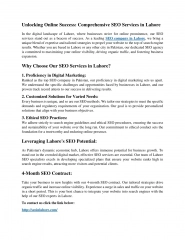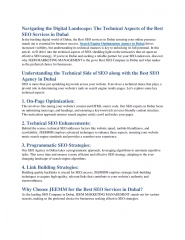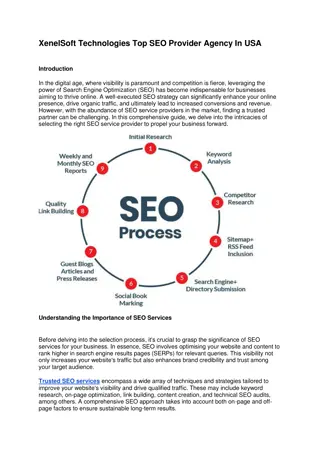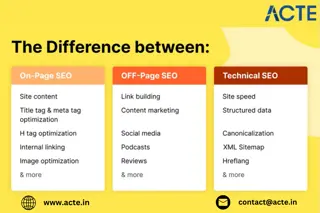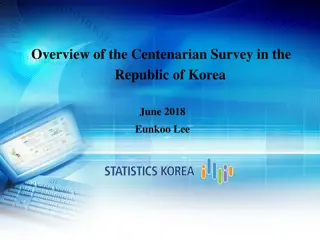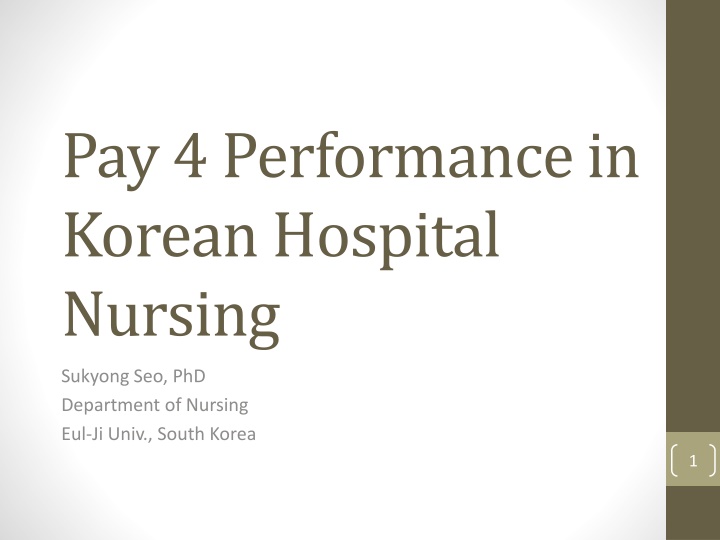
Nursing Staffing Incentives in South Korean Hospitals
Exploring the impact of financial incentives on nursing resources in South Korean hospitals, particularly focusing on the effects of Pay for Performance (P4P) programs implemented by the National Health Insurance Services. The study investigates the relationship between nurse staffing levels, quality of care, and hospital investments in nursing resources, providing insights into the effectiveness of incentivizing hospitals based on nurse staffing metrics.
Download Presentation

Please find below an Image/Link to download the presentation.
The content on the website is provided AS IS for your information and personal use only. It may not be sold, licensed, or shared on other websites without obtaining consent from the author. If you encounter any issues during the download, it is possible that the publisher has removed the file from their server.
You are allowed to download the files provided on this website for personal or commercial use, subject to the condition that they are used lawfully. All files are the property of their respective owners.
The content on the website is provided AS IS for your information and personal use only. It may not be sold, licensed, or shared on other websites without obtaining consent from the author.
E N D
Presentation Transcript
Pay 4 Performance in Korean Hospital Nursing Sukyong Seo, PhD Department of Nursing Eul-Ji Univ., South Korea 1
Healthcare Quality Quality assessment : Avedis Donabedian, 1980 In my discussion of the context of quality assessment I pointed out that as attention shifts from the interaction of one patient-practitioner pair to the provision of care by groups of practitioners to entire populations, a number of attributes of care become much more prominent determinants of the quality of care . Approach: Structure, Process, and Outcome 2
Pay 4 Performance & Quality Health care The rationale behind Paying for Performance(P4P) in health care is that if compensation is directly linked to quality of care, providers will shift more effort towards quality improvement. Adopted in health care as a means to alter financial incentives of providers. Well aligned providers main financial incentives with meeting quality targets successful 3
Contents Introduction & purpose of Study Health system in Korea Methods & Results Conclusions Policy implications 4
Introduction The number of active nurses per 100 acute beds was about 4.8 in Korean(1990s), which was quite low compared with Western standards Compelling evidences that nurse staffing directly influences quality of care Rewarding hospitals according to their staffing levels may be an effective way to increase hospital investment in nursing resources However, raising staffing levels requires substantial capital investment. The bonuses linked to P4P metrics are often too small to cover the labor costs required. 5
In 1999, the social insurance in South Korea(National Health Insurance Services, NHIS) reformed the hospital payment method to provide acute hospitals with incentives based on level of nurse staffing In 2007, added a disincentive, whereby hospitals failing to reach a threshold level had to pay penalties A decade of experience in South Korea provides a testable case to examine the effectiveness of financial incentives to increase nursing resources. 6
Brief overview of the health care system in South Korea Korea s social health insurance since 1977 - Expanded; limited population businesses with fewer employs & self employed population - Subsidized by government; 35-50% 20% - Subsidies as a share of total general government expenditures; 0.7% 4.1% Household premiums subsidized by employers & government Consumer out-of-pocket payment (20-55%) not covered by social insurance 7
Brief overview of the health care system in South Korea Medical providers compensated on a fee-for-services (FFS) basis Committee for Financial Management - Sets the medical fee schedules and defines the scope of national health insurance coverage and benefits - Kept fee schedules very low, often not covering actual costs for some services, and excluding coverage for many expensive services An independent agency, the Health Insurance Review and Assessment Service (HIRA) authoritative to make strategic purchasing reviewing provider payment scheme and fee schedules, auditing insurance claims, and assessing quality of health care providers established pay-for-performance (P4P) and public reporting programs 8
9 Source: Ministry of Health and Welfare
Building blocks of the P4P A monitoring system, price setting, and an adjustment system 1) Monitoring collects data on each hospital s nurse staffing on a quarterly basis following the assessment, pays for that quarterly nursing fee (the Nursing Administration Fee) Separates the revenue category of nursing care from the daily room-and-board charge the nursing fee - based on a per-bed ratio, not accounting for nursing intensity provided for each patient 10
Building blocks of the Korean Nursing P4P 2) Price setting Sets up six grades: hospitals are paid 100% of the base nursing fee (per diem per patient rate) by NHIS when complying with the minimum requirement (Grade 6) The value of base rate is annually determined through the National Health Insurance Policy Review Committee chaired by the vice minister of health and welfare As it advances into the upper grades, the capital benefits that a hospital would gain increase by 40% of the base rate At the highest level, a hospital is paid 300% of the fee (Grade 1) 3) Actual payment adjusting factors By grouping hospitals according to cost related to hiring nurses 11
Purpose of study To examine whether the payment incentive leads hospitals to increase nurse staffing To examine whether the response to the nursing incentive has been consistent across hospitals with various financial statuses To examine whether the resulting staffing changes improved nurses working conditions 13
Data Sources Annual financial reports (1996-2005) on 756 - 1,525 hospitals including short-term acute hospitals, excluding psychiatric, specialty, and long-term care hospitals inpatient units only 2010 nationwide survey of hospital RNs performed by the Korean Health and Medical Workers Union to learn whether work conditions were improved following payment reform 2,387 RNs from 29 nationwide hospitals including medical-surgical units and obstetrics and gynecological units, excluding the ICUs, OR, and EDs 14
Measures Nursing payment reform pre-policy years (1996 and 1999) intervention year (1999) post-policy years (2002, 2005, 2008) post intervention 1 post intervention 2 post intervention 3 Nurse staffing level grade 1 grade 6 (currently) whether the level had improved since 2005 (by 1 grade, by 2 grade, no improvement). 15
Nurses work conditions job satisfaction, burnout, and intention to leave job satisfaction: 4-point Likert-type scale (1 = very dissatisfied, 2 = dissatisfied, 3 = satisfied, and 4 = very satisfied) degree of burnout: the Maslach Burnout Inventory Human Services Survey, (Maslach, Jackson & Leiter 1986) intention to leave current employer was measured by a single item asking, Are you intending to leave your current employer(s) within a year? Characteristics of nurses age, marital status, years of nurse experience, position (charge or staff nurse), and education current employer: number of beds, location Hospital characteristics Hospital type, size, location, ownership, teaching status, etc Hospital type was categorized as General hospital : 100 licensed beds and met particular criteria Hospital: 30 to 100 licensed bed 16
Statisticalanalysis First, analyzed the trend of nursing staffing by comparing data from before the policy with that from after the policy Next, estimated what factors affected the changes in nurse staffing by using multivariate regressions Controlled for the factors pertinent hospitals staffing decisions (location, hospital type, size, case mix) Last, multilevel logistic regression analysis to examine whether hospital nurses had perceived improvements in their working conditions after the nursing payment reform Applied multilevel specifications to control for the hospital effect since respondents coming from the same hospitals shared the same work conditions as well as other organizational characteristics 17
Table 1. Descriptive statistics of Koreas acute hospitals, 1996-2008 1996 1999 2002 2005 2008 n % n % n % n % n % General Hospital 275 36.38 275 32.66 275 28.86 286 22.27 303 19.87 Hospital Type Hospital 481 63.62 567 67.34 678 71.14 998 77.73 1,222 80.13 Public 122 16.14 100 11.88 103 10.81 139 10.83 119 7.8 Ownership* Private 619 81.88 742 88.12 850 89.19 1145 89.17 1,406 92.2 Capital city and neighbor Metropolita n 280 37.04 294 34.92 322 33.79 399 31.07 460 30.16 Location 176 23.28 232 27.55 274 28.75 379 29.52 438 28.72 Rural 300 39.68 316 37.53 357 37.46 506 39.41 627 41.11 Yes 246 32.54 226 26.84 210 22.04 217 16.9 199 13.05 Training Hospitals no 510 67.46 616 73.16 743 77.96 1067 83.1 1,326 86.95 100 18 Total 756 100 842 100 953 100 1284 100 1,525 * 1996: missing 154
Figure 1. Average number of nursing workforce in Korean hospitals,1996 -2008 19
Table 2. Estimates of the effect of P4P in the nursing payment on nurse staffing in Korean hospitals Dependent variable: Number of RNs(log) Variables Estimate SE p-Value General Hospital (referent to Hospital) 0.06 <.0001 0.442 Number of beds Number of patient discharges Public ownership (referent to private) Location (referent to rural area) Capital city & neighbor Metropolitan Teaching status (referent to non-teaching hospitals) Policy period (referent to 1996) Policy intervention (1999) Post intervention 1 (2002) Post intervention 2 (2005) Post intervention 3 (2008) Hospital type & Policy interactions Hospital*policy Hospital*post intervention 1 Hospital*post intervention 2 Hospital*post intervention 3 0.015 0.009 0.03 <.0001 <.0001 <.0001 0.629 0.423 0.257 0.022 0.022 0.032 <.0001 <.0001 <.0001 0.244 0.165 0.212 0.06 0.06 0.06 0.059 <.0001 <.0001 <.0001 <.0001 0.236 0.386 0.472 0.436 0.034 -0.045 -0.081 -0.166 0.072 0.071 0.07 0.069 0.64 0.524 0.247 0.016 20 N4,902 Adj R-Sq0.792
Table 3. Descriptive statistics on hospital nurse survey in 2010 n 407 791 1189 1123 862 402 570 1096 485 99 98 0 568 1094 625 % 17.05 33.14 49.81 47.05 36.11 16.84 24.28 46.68 20.66 4.22 4.17 0 24.84 47.84 27.33 Less than 500 500-799 More than 800 Capital area Metropolitan Rural Grade 1 Grade 2 Grade 3 Grade 4 Grade 5 Grade 6 No change Advanced by 1 grade Advanced by 2 + grade Number of beds Location Level of Nurse Staffing Changes in staffing grade, past 5 years Demographics of RNs Age <25 25-29 >=30 married no married <5 5-9 >=10 staff nurse charge nurse head nurse 3 year nursing program College graduate Master s or higher 621 989 777 662 1708 1302 617 468 2,164 158 40 1,234 996 134 2,387 26.02 41.43 32.55 27.93 72.07 54.55 25.85 19.61 91.62 6.69 1.69 52.2 42.13 5.67 100 Marital status Experiences (years) Positions 21 Education Total
Table 4. Changes in staffing levels and nurses work conditions in Korean hospitals Job satisfaction (%) High burn out(%) Intention to leave (%) chi sq (p) chi sq (p) chi sq (p) unsatisfied satisfied N no yes N no yes N No change 70.72 29.28 567 5.463 25.09 74.91 562 4.53 63.09 36.91 550 6.993 Advanced by 1 grade 68.41 31.59 1089 (0.065) 26.46 73.54 1077 (0.104) 68.97 31.03 1070 (0.032) Advanced by 2+ grades 64.52 35.48 620 30.29 69.71 614 69.36 30.64 607 N 67.93 32.07 2276 27.16 72.84 2253 67.62 32.38 2227 22
Table 5. Estimates of the effect of the nursing payment reform on nurse s work conditions in Korean hospitals Job Satisfaction High burn out Intention to leave Dependent variables OR 95% CI OR 95% CI OR 95% CI Variables Changes in nurse staffing grade, past 5 years (referent to no change) Advanced by 1 grade 0.994 1.217 1.153 (0.574 1.723) (0.627 2.363) (0.717 1.854) Advanced by 2+ grades 0.887 1.314 1.579 (0.429 1.835) (0.549 3.141) (0.834 2.991) Note: All regression models include nurse demographics (age, marital status, years of nurse experience, position, education) and hospital characteristics (number of beds, location, levels of nurse staffing). 23
Conclusions Examining a decade of experience in P4P in Korean hospital nurse staffing, this study shows thatthe approach is somewhat effective for the general hospitals with adequate resources to invest in nurse staffing, but less so with the hospitals that lack such resources. Our findings inform policymakers in other countries that a policy to incentivize nurse staffing using P4P can be more effective by considering those hospitals in poor financial shape. 24
Policy implications Linking institution-level nurse staffing to payment is effective in improving nurse staffing in the hospital sector. This approach could be added to already existed staffing regulations such as minimum nurse-to-patient ratios or patient classification systems. To be more effective, careful considerations for hospitals in poor financial shape are required when designing and implementing this approach. Surprisingly, nurse outcomes including job dissatisfaction, burnout, & intention to leave were not significantly improved, while overall staffing increased. Investment to improve nurse work conditions is required to increase staffing levels. 25

